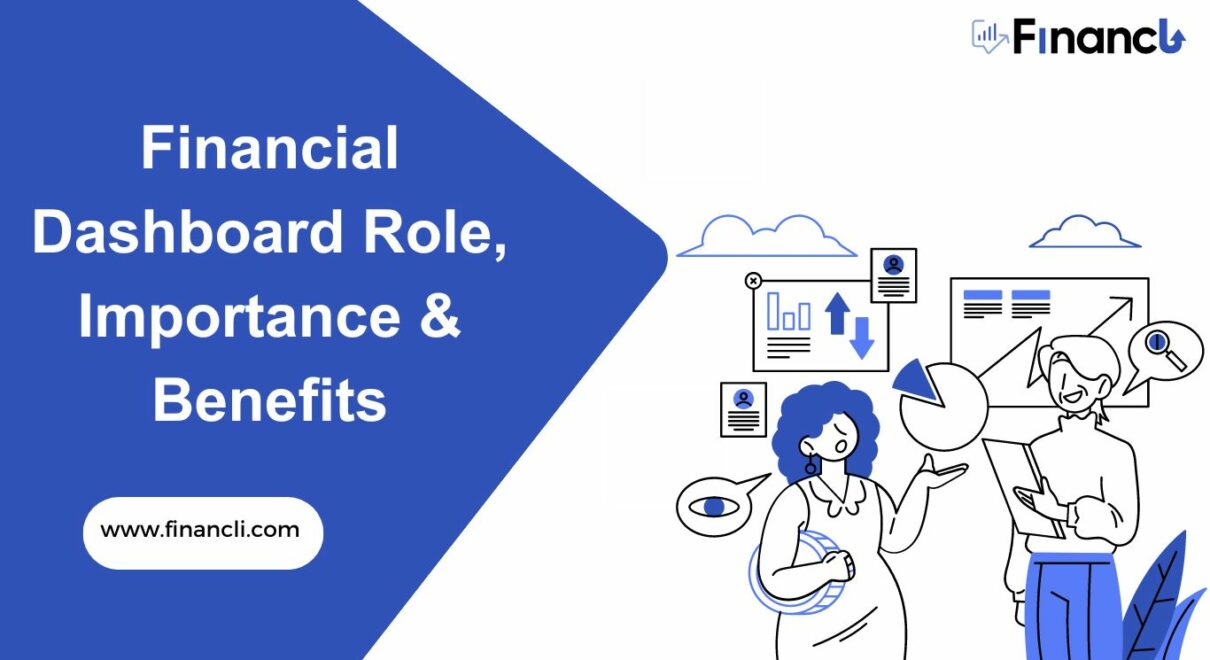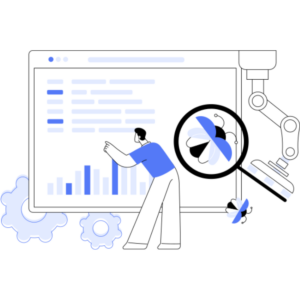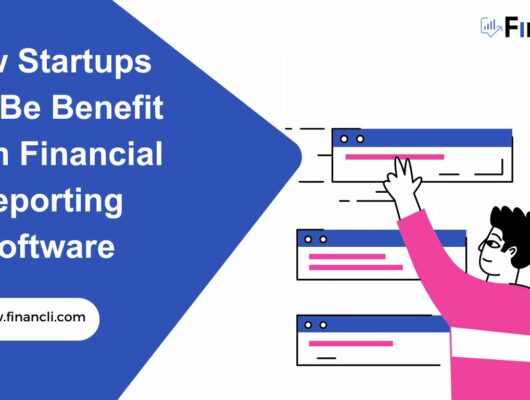Financial Dashboard Role, Importance & Benefits
In today’s rapidly evolving world, effective financial management is more crucial than ever before. From tracking expenses to monitoring investments and planning for the future, staying on top of your financial health can be a daunting task. However, with the advent of financial dashboard, managing your money has never been more accessible or more convenient.
What Exactly is a Financial Dashboard?

A financial dashboard is essentially a digital tool that displays crucial financial information and performance metrics clearly and concisely. It consolidates data from various sources, such as accounting systems, spreadsheets, and databases, and presents it through charts, graphs, and tables. This visual representation allows users, such as business owners, executives, and financial managers, to quickly assess the financial health of their organization, identify trends, and pinpoint areas that require attention.
Financial Dashboard Examples
By providing real-time or near-real-time data, financial dashboards enable users to make informed decisions promptly, leading to better financial management and strategic planning. Below are some examples of financial dashboards:
Revenue Trends
This dashboard tracks how the company’s revenue is evolving over a specified period, whether it’s increasing, decreasing, or remaining stable. It assists businesses in comprehending their sales trajectory and recognizing patterns or trends that could influence future revenue generation.
Expense Breakdown
This dashboard breaks down the company’s expenses into categories such as salaries, marketing, utilities, etc. It provides insights into where the money is being allocated, helping management identify areas for cost optimization or investment.
Profit Margins
The profit margins dashboard indicates the company’s profitability by comparing revenue to expenses. A high-profit margin suggests efficient operations, while a low margin may indicate areas of inefficiency that need addressing.
Cash Flow Analysis
Cash flow analysis dashboard tracks the movement of cash into and out of the company over a specified period. It helps businesses understand their liquidity position, ensuring they have enough cash to cover operational expenses, investments, and debt obligations.
Key Performance Indicators (KPIs)
These dashboards record specific metrics that measure various aspects of the company’s performance, such as customer acquisition cost (CAC), inventory turnover, or customer lifetime value (CLV). KPIs offer actionable insights into essential aspects of the business, empowering management to make informed decisions and foster improvement.
The Role of Financial Dashboards in the Financing Process

Financial dashboards are instrumental in the financing process, offering stakeholders real-time insights into the company’s financial performance, which is crucial for making well-informed financing decisions. Here’s how financial dashboards contribute to the financing process:
Monitoring Financial Health
Financial dashboards allow stakeholders, including executives, investors, and lenders, to monitor the company’s financial health in real time. By providing vital financial metrics such as revenue, expenses, cash flow, and profitability, dashboards enable stakeholders to assess the company’s current financial position and make informed decisions regarding financing options.
Identifying Funding Needs
Financial dashboards help identify funding needs by highlighting areas where additional capital may be required. For example, if the dashboard shows declining cash reserves or increasing expenses, it may indicate a need for additional funding to support operations or expansion initiatives.
Evaluating Financing Options
Financial dashboards facilitate the evaluation of different financing options by providing insights into the company’s ability to meet debt obligations, manage cash flow, and generate returns for investors. By analyzing key financial metrics on the dashboard, stakeholders can assess the suitability of various financing options, such as bank loans, equity financing, or mezzanine financing.
Communicating with Stakeholders
Financial dashboards serve as a communication tool for stakeholders, allowing companies to transparently share financial information with investors, lenders, and other stakeholders. Dashboards contribute to building trust and confidence among stakeholders by offering real-time access to financial data and performance metrics, which is crucial for securing financing.
Tracking Financial Performance
Financial dashboards enable stakeholders to track financial performance over time and monitor progress toward financial goals and targets. By comparing actual performance against budgeted or forecasted figures, stakeholders can identify variances and take corrective actions to meet financial objectives.
Supporting Due Diligence Processes
In financing transactions such as debt financing or equity investments, due diligence is critical in assessing the company’s financial health and viability. Financial dashboards provide a centralized platform for organizing and presenting financial information, streamlining the due diligence process for investors and lenders.
Overall, financial dashboards play a vital role in the financing process by providing stakeholders with timely and relevant financial information, facilitating decision-making, and supporting transparent communication between companies and their investors, lenders, and other stakeholders.
Importance of Financial Dashboards:
Financial dashboards are essential tools in modern financial management, providing a consolidated view of an organization’s financial health. Here’s why they are crucial:
Real-Time Insights
Financial dashboards offer up-to-the-minute visibility into key financial metrics, allowing stakeholders to make timely decisions based on current data. This ensures that decisions are informed by the most recent financial information, enhancing accuracy and relevance.
Enhanced Decision Making
Empowered with precise and current financial data, dashboards enable stakeholders to make informed decisions that in turn fuel business growth and profitability. Moreover, comprehensive insights enable decision-makers to evaluate options effectively and choose the most strategic course of action.
Efficiency and Productivity
Centralizing financial data and automating reporting processes, dashboards streamline financial management tasks, thus freeing up resources for strategic initiatives and improving operational efficiency. In addition, by eliminating manual data gathering and analysis, dashboards enable teams to focus on value-added activities that in turn contribute to organizational success.
Goal Tracking and Performance Management
Dashboards facilitate setting financial goals, tracking progress, and measuring performance against benchmarks, driving continuous improvement and accountability across the organization. By providing a clear overview of goal attainment, dashboards help teams stay focused and aligned with organizational objectives.
Improved Communication and Collaboration
By providing a shared platform for accessing financial information, dashboards foster transparency and alignment among stakeholders, thereby enhancing communication and collaboration within the organization. Furthermore, open dialogue and knowledge sharing facilitated by dashboards lead to better decision-making and problem-solving.
Risk Identification and Management
By means of dashboards, businesses can proactively identify and mitigate financial risks by flagging potential issues or anomalies in performance metrics. Consequently, early warning indicators enable organizations to take preventive measures to avoid adverse outcomes and protect their financial stability.
Strategic Planning and Forecasting
Insights gleaned from financial dashboards, organizations can inform long-term strategic planning and forecasting by highlighting trends and patterns in financial performance. Furthermore, through the analysis of past data and forecasting future scenarios, organizations can make well-informed decisions regarding resource allocation, investment strategies, and growth initiatives, thus ensuring long-term sustainability and success.
Benefits of Financial Dashboards:
Financial dashboards offer numerous advantages to businesses, including:
Visibility and Transparency
Dashboards provide a clear and concise view of financial performance, promoting transparency and accountability among stakeholders.
Real-Time Monitoring
Continuous monitoring of key financial metrics empowers stakeholders to identify trends, detect anomalies, and respond promptly to changing market conditions.
Data-Driven Decision-Making
Access to precise and current financial information facilitates data-driven decision-making, empowering stakeholders to make informed choices that propel business growth and profitability.
Efficiency and Productivity
Improving operational efficiency by streamlining financial management tasks and automating reporting processes enables stakeholders to dedicate their focus to strategic activities that contribute value to the organization.
Goal Tracking and Performance Management
Dashboards facilitate setting and tracking financial goals, driving accountability and continuous improvement across the organization.
Improved Communication and Collaboration
Providing a shared platform for accessing financial information enhances communication and collaboration among stakeholders, fostering transparency and alignment.
Risk Identification and Management
Dashboards help businesses proactively identify and mitigate financial risks, safeguarding the company’s financial stability.
Strategic Planning and Forecasting
The insights derived from financial dashboards inform long-term strategic planning and forecasting, empowering businesses to seize opportunities and effectively address challenges.
Frequently Asked Questions:
How do you build a financial dashboard?
-Building a financial dashboard typically involves selecting a platform or tool that meets your needs, importing your financial data, and customizing the dashboard to display the metrics you want to track.
How to automate financial reporting dashboards and reports?
-Numerous financial dashboard platforms provide automation features, enabling users to schedule reports for automatic execution at regular intervals, thereby saving time and effort.
Conclusion
In conclusion, financial dashboards are powerful tools that can help you take control of your finances and work towards your financial goals. Financial dashboards empower users to make informed decisions and achieve financial success by offering real-time insights, customization options, automation features, and other functionalities. So why wait? Start exploring the world of financial dashboards today and take the first step towards a brighter financial future!







